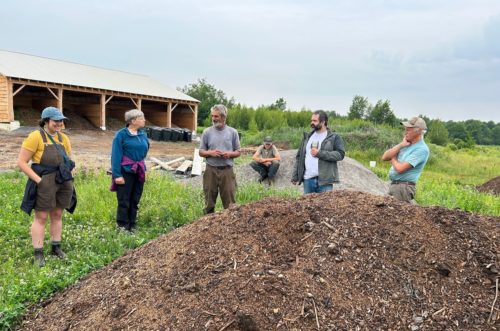By John Culpepper, co-founder of Compost for Good
There are exciting technologies now available to grow a substantial amount of food in aquaponic and aeroponic systems. There are even giant warehouses where tens of thousands of pounds of lettuce and other greens are grown and harvested under highly efficient LED lighting, using robots. However, as productive as these facilities can be, the vast majority of the world’s plants and animals grown for human consumption still rely on soil.
What is soil? I spent years in college, studying the properties of soil, earning degrees along the way from prestigious universities. My studies of soil science were enormously valuable. However, something critical was missing from my education.
What we are now beginning to be aware of is that there is another component of the soil that many say is even more important than physical and

In June 2023, workshop and tour participants learned about aerated static pile composting from Dan Whitten of Whitten Family Farm in Winthrop, NY.
chemical properties. This component is life—literally billions upon billions of individual organisms in a small handful of good soil.
On the one hand, understanding the vast number of interactions among different species found within soil, and how they interact with plants is enormously complicated. On the other hand, the story is rather simple. For example, if a farmer wants to reduce or eliminate pesticides, herbicides, miticides, fungicides, irrigation, and weeds, they just have to make sure that they pay attention to the soil biology, and when needed, improve and maintain that biology. This requires a relatively inexpensive microscope, the knowledge of what to look for, and the knowledge of how to tweak soil biology so that the crop the farmer wants to grow can thrive. The same is true for lawns, sports fields, golf courses, and other grassy areas.
In the past several years I have been increasing my understanding of soils and soil health through numerous articles, discussions with others, YouTube videos, and formal classes. I am as energized to learn about this aspect of soil science as I was when I first started college classes at 17.
This growing understanding of how to repair damaged soils comes at a time when soils around the world are in decline, requiring more and more expensive inputs, while declining in overall productivity. The ability to feed the billions of people on this planet depends on a better, and clearer understanding of what constitutes soil health. The good news is that improving soil is not expensive, and doesn’t require continuous applications of products. It does however require the knowledge of how to re-establish native microbiological communities and how to maintain those tireless little workers.
You don’t have to be a farmer to benefit from this emerging understanding of soil health. Whether you own a land, or are associated with a school, church, or other institution, you can help to bring this understanding to those who manage lawns, sports fields, or gardens.
Compost for Good can help. Contact ANCA’s Organics Recycling Coordinator and Compost for Good co-founder Jennifer Perry at [email protected].
In Fall 2022, ANCA and AdkAction joined forces to expand funding and support for Compost for Good. The initiative was launched in 2018 by co-founders John Culpepper, Katie Culpepper and Jennifer Perry to bring community-scale composting research and implementation opportunities to North Country farms, institutions, businesses and communities.
